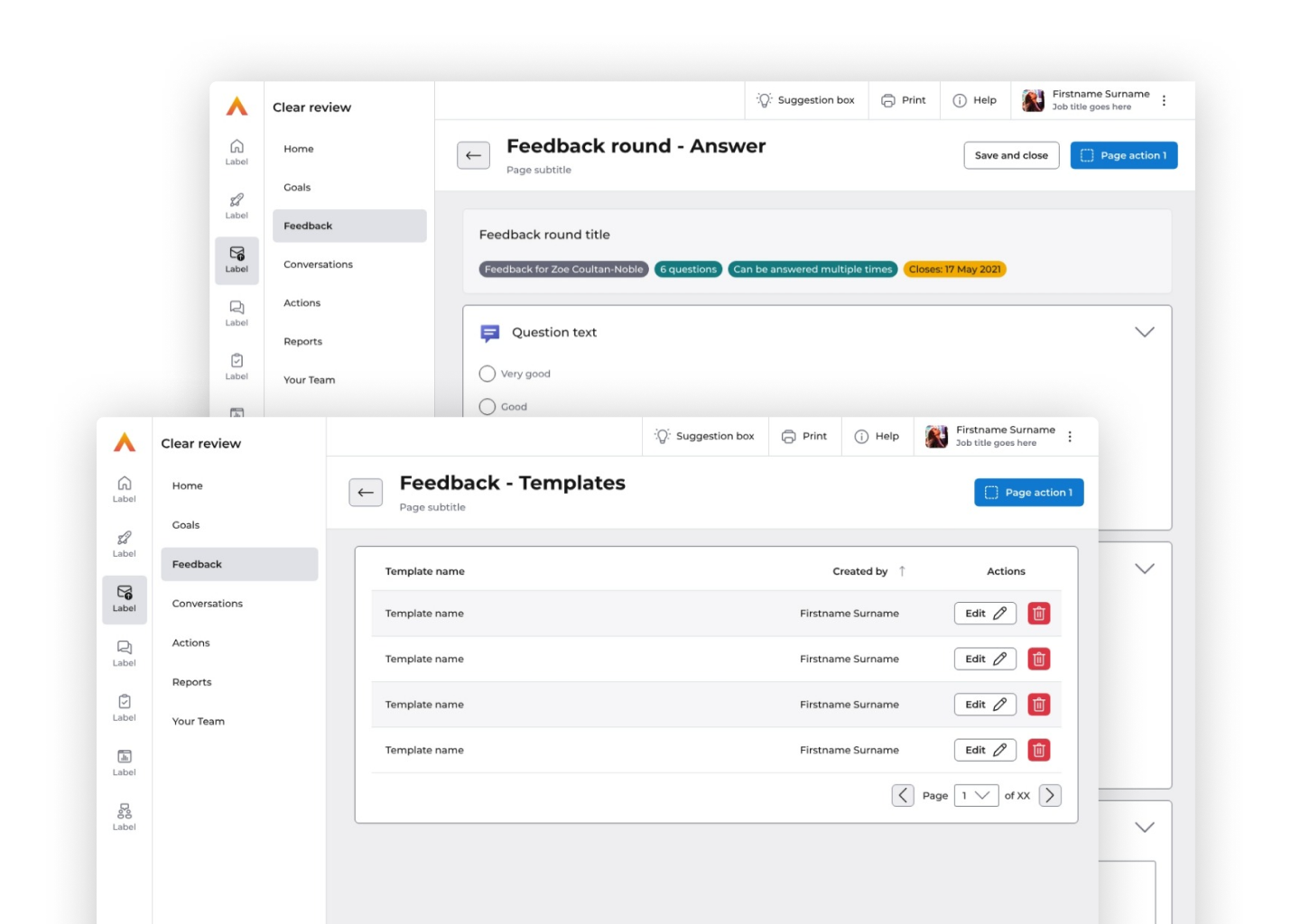Project Info
Project role: UX Lead including close collaboration with UX copy and the development team.
Product Description: This feature is part of an overall larger 360 feedback piece of functionality within a product called 'Clear Review'. 'Clear Review' is a HR based performance management tool used within some of the biggest brands in the world to help increase feedback culture.
Project time: This project is a small piece of functionality within a feature that is part of a larger on-going project.
Please note: Some sections of these designs have been removed for legal reasons. Some copy may appear inconsistent or missing.
results
final designs
Product Description: This feature is part of an overall larger 360 feedback piece of functionality within a product called 'Clear Review'. 'Clear Review' is a HR based performance management tool used within some of the biggest brands in the world to help increase feedback culture.
Project time: This project is a small piece of functionality within a feature that is part of a larger on-going project.
Please note: Some sections of these designs have been removed for legal reasons. Some copy may appear inconsistent or missing.
Challenge Statement
To design functionality in order to create, manage, release and maintain templates that can be used throughout a company in order to gather feedback on activities like 'performance, projects and conference presentations' as part of an overall 360 feedback piece of functionality.
Understanding the problem
• Current 360 feedback functionality puts the control into the company's/HR's hands, we want to ensure that employees take control of their own feedback as well as their personal development.
• 360 templates are currently used once per year for performance reviews or once per quarter. Do different teams need different templates?
• Users can't take control of their feedback when there isn't enough flexibility.
• 360 templates are currently used once per year for performance reviews or once per quarter. Do different teams need different templates?
• Users can't take control of their feedback when there isn't enough flexibility.
What We already know
• Existing designs and the workflow is confusing and not currently fit for purpose.
• Has many personas, all potentially using cross functionality.
• Users forget to fill out feedback forms/surveys. Reminders need reviewing.
• Users are in busy fast paced work environments. Feedback forms can currently take a while to setup with the current process.
• Has many personas, all potentially using cross functionality.
• Users forget to fill out feedback forms/surveys. Reminders need reviewing.
• Users are in busy fast paced work environments. Feedback forms can currently take a while to setup with the current process.
The Research
• Looking at any previous data available in Pendo in order to identify existing pain points and similar successful patterns/mechanisms.
• Review the existing template designs.
• Explore existing product feedback including NPS and support data to identify any opportunities for improvement relating to this process. Are there any quick wins we can include?
• Fact finding workshop with existing customers work group.
• Find out why users feel that the existing designs and workflow are confusing and aren't currently fit for purpose. - Where are the gaps?
• Explore and understand the personas for this functionality in more detail.
• UX Benchmarking - Take a look at how this templates piece fits in with the existing designs for 360 feedback and existing surveys with different styles within the system. - Do we need a phased approach due to dev capacity?
• Review the existing template designs.
• Explore existing product feedback including NPS and support data to identify any opportunities for improvement relating to this process. Are there any quick wins we can include?
• Fact finding workshop with existing customers work group.
• Find out why users feel that the existing designs and workflow are confusing and aren't currently fit for purpose. - Where are the gaps?
• Explore and understand the personas for this functionality in more detail.
• UX Benchmarking - Take a look at how this templates piece fits in with the existing designs for 360 feedback and existing surveys with different styles within the system. - Do we need a phased approach due to dev capacity?
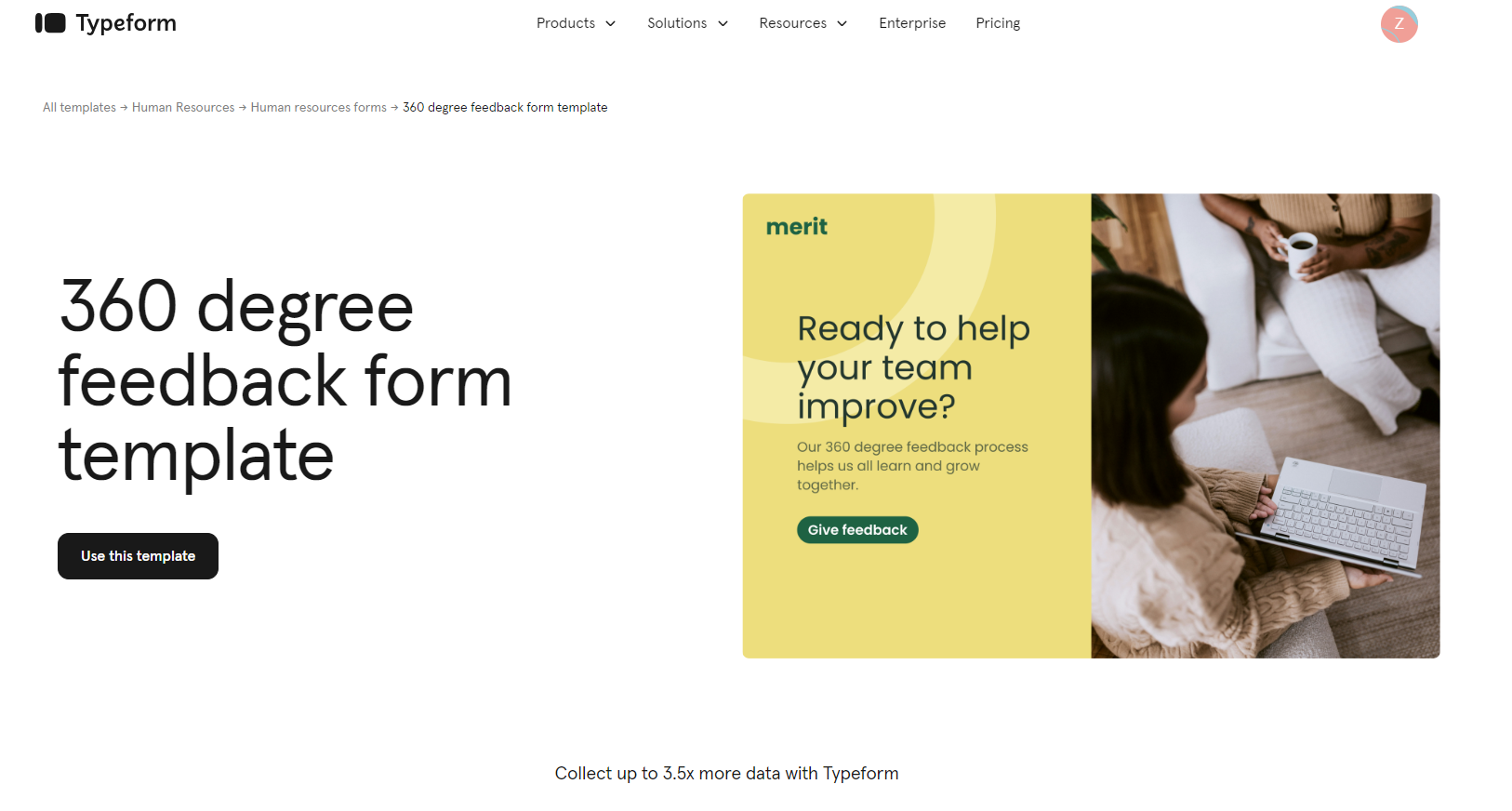
It takes 3 steps to get to the template you want to use before you use it. The templates section is also not easy to locate when setting up a new survey. You also can't make your own templates.

Typeform also provides users with best practises to fill out the survey, an idea I liked and kept for when we designed the survey building part of the project so HR admins could provide this to employees and managers.
Reviewing Existing Designs
• Lack of flexibility, only certain types of survey style questions, this restricts feedback. 'Any further comments?' boxes are a must!
• Can't edit templates and no 'draft mode' before publishing.
• We must consider implementing reminders. Should this still be an email? Should we reduce/increase our frequency?
• UX inconsistencies that don't align with all of the product and the platform as a whole.
• Glaring accessibility issues with contrast and ARIA tags.
• Can't edit templates and no 'draft mode' before publishing.
• We must consider implementing reminders. Should this still be an email? Should we reduce/increase our frequency?
• UX inconsistencies that don't align with all of the product and the platform as a whole.
• Glaring accessibility issues with contrast and ARIA tags.
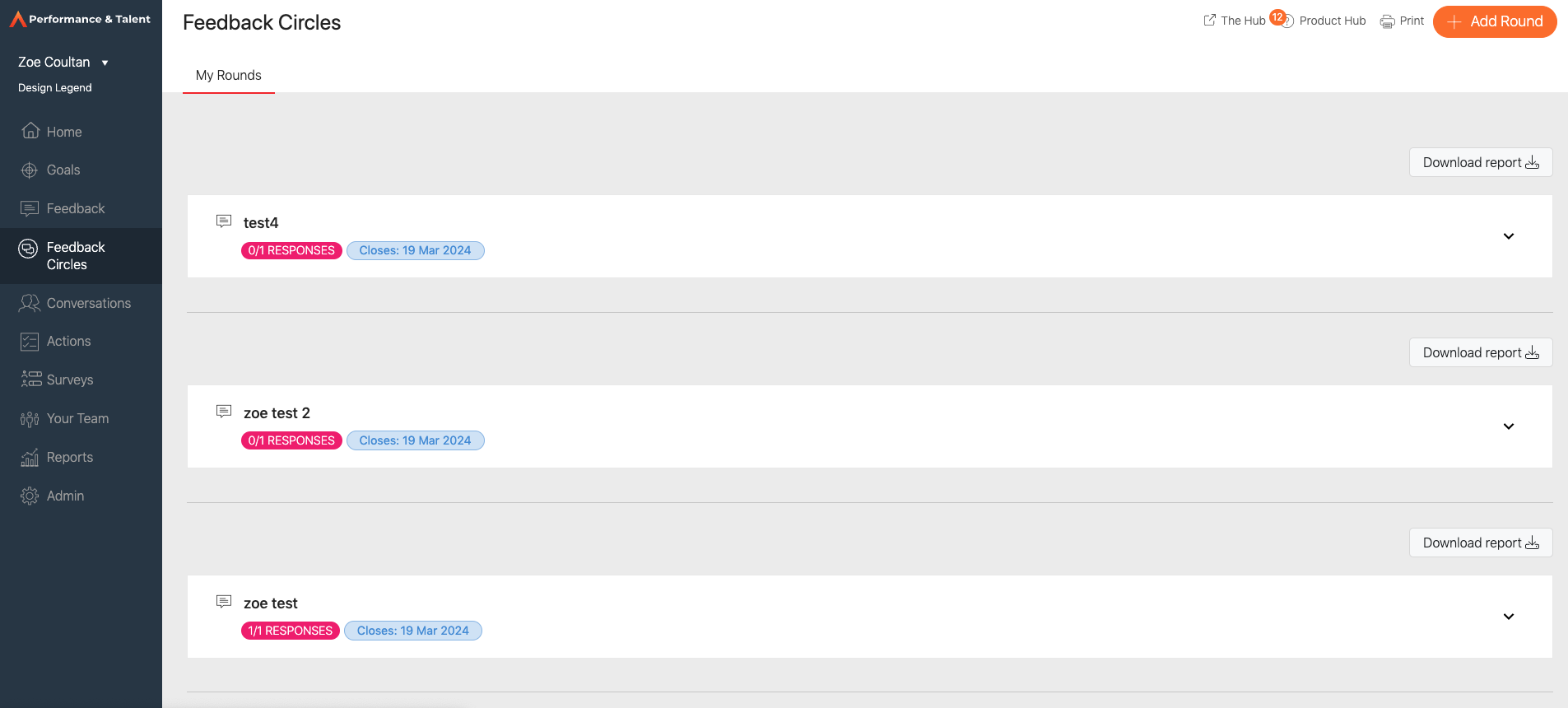
Round overview page - employee persona
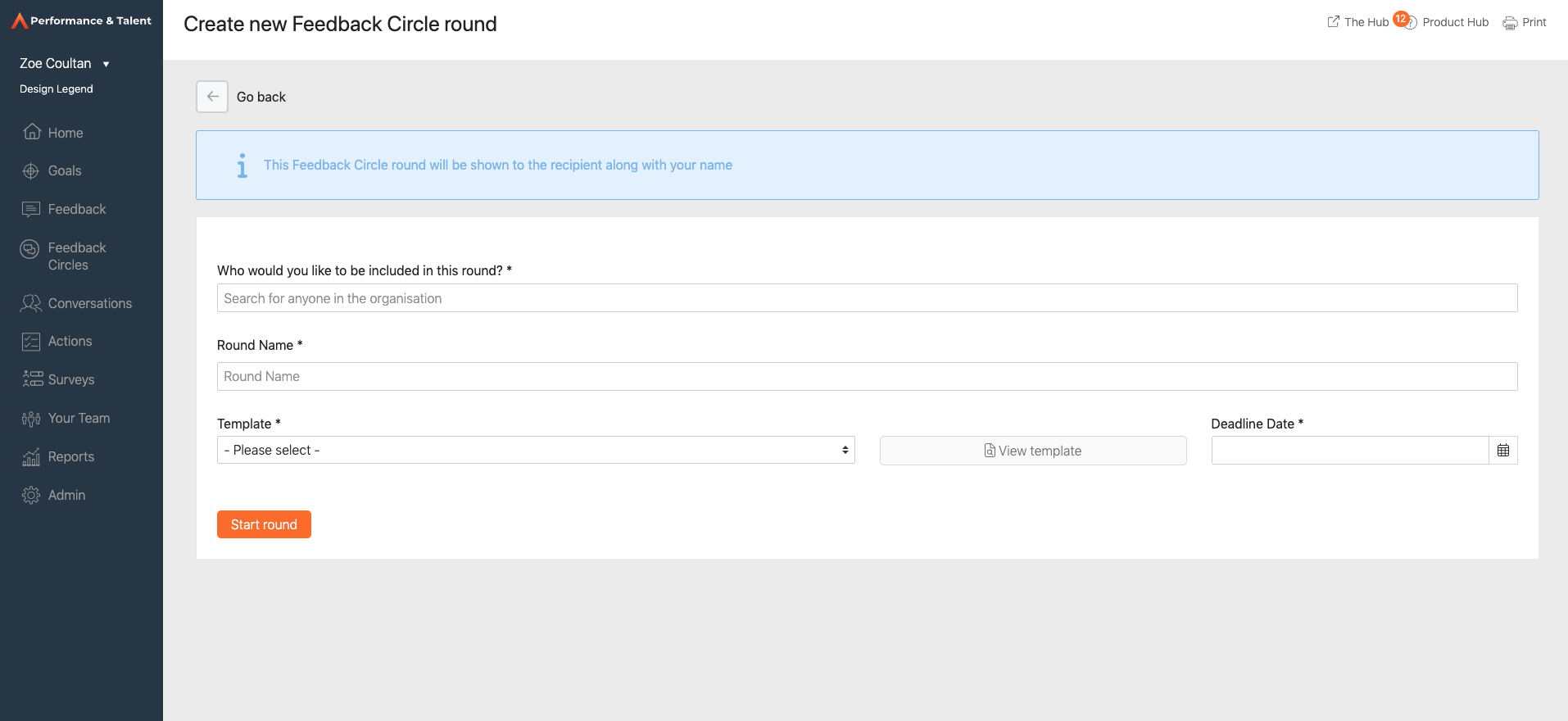
Create a new Feedback round - employee persona

An example of the existing 360 template design style.
Speaking to Existing Customers
Customer Feedback Group
As part of our ongoing feedback loop we have a group of customers and members from organisations
Initial Feedback on the Existing Functionality
• Feels like a formality that the company requires, rather than the employee/user having any control.
• Nowhere for users to add more info if the questions/answers don't fit their response.
• Once the template is sent out, you can't change it.
• No ability to lock templates down.
• Some users mentioned some issues with what to write when creating the survey.
Customer Wants for the New Functionality
• Customers feel that flexibility of question styles will be the key to success (including templates).
• The ability to 'chop and change' questions if they are not working.
• Lock templates and control who is able to write them.
• Email reminders would be helpful.
As part of our ongoing feedback loop we have a group of customers and members from organisations
Initial Feedback on the Existing Functionality
• Feels like a formality that the company requires, rather than the employee/user having any control.
• Nowhere for users to add more info if the questions/answers don't fit their response.
• Once the template is sent out, you can't change it.
• No ability to lock templates down.
• Some users mentioned some issues with what to write when creating the survey.
Customer Wants for the New Functionality
• Customers feel that flexibility of question styles will be the key to success (including templates).
• The ability to 'chop and change' questions if they are not working.
• Lock templates and control who is able to write them.
• Email reminders would be helpful.
Research findings - How might we?
• Put the employee in charge of their own feedback by allowing them to take charge of their own templates.
• Make it easy to create surveys with a consistent UX approach that aligns with both the product and the platform.
• Ensure considerations are made for each persona, especially for users that span multiple personas.
• Ensure business needs are met, employee feedback should help drive personal and company performance.
• Lock/restrict access to templates for certain users to some templates.
• Allow users to create their own style of templates, not just multiple choice etc.
• Ensure users can edit their template at a later date. Add/remove questions, change the wording etc.
• Allow for a 'comments' section at the end of every question in order for users to add any further details they wish. - Do not assume the questions will cover everything.
• Ensure reminders to fill out the forms are sent at well timed intervals and consider if email is still appropriate.
• Support users with knowing what to write when creating the rounds.
• Make it easy to create surveys with a consistent UX approach that aligns with both the product and the platform.
• Ensure considerations are made for each persona, especially for users that span multiple personas.
• Ensure business needs are met, employee feedback should help drive personal and company performance.
• Lock/restrict access to templates for certain users to some templates.
• Allow users to create their own style of templates, not just multiple choice etc.
• Ensure users can edit their template at a later date. Add/remove questions, change the wording etc.
• Allow for a 'comments' section at the end of every question in order for users to add any further details they wish. - Do not assume the questions will cover everything.
• Ensure reminders to fill out the forms are sent at well timed intervals and consider if email is still appropriate.
• Support users with knowing what to write when creating the rounds.
Plan of action
• Create a low fidelity prototype/wireframes in order to test and identify which mechanisms will create the fastest and easiest to use version of the functionality.
• Work closely with the developers to work on ways to introduce elements of the new design system (being implemented across the platform) as part of this functionality, is there anything we could squeeze in as part of a phased transition to the Mosaic Design System? A font change potentially in order to get ahead of the project?
• Ensure that user requirements can be completed as part of the scope.
• Work closely with the developers to work on ways to introduce elements of the new design system (being implemented across the platform) as part of this functionality, is there anything we could squeeze in as part of a phased transition to the Mosaic Design System? A font change potentially in order to get ahead of the project?
• Ensure that user requirements can be completed as part of the scope.
Initial Sketches - Ideating with the PM and PO
With this particular PM and PO, when in the initial stages of a project with lots of different avenues and initial questions to be answered, we hash lots of ideas out quickly on a Miro board or just on paper.

Getting initial ideas down - what might work, what might not.
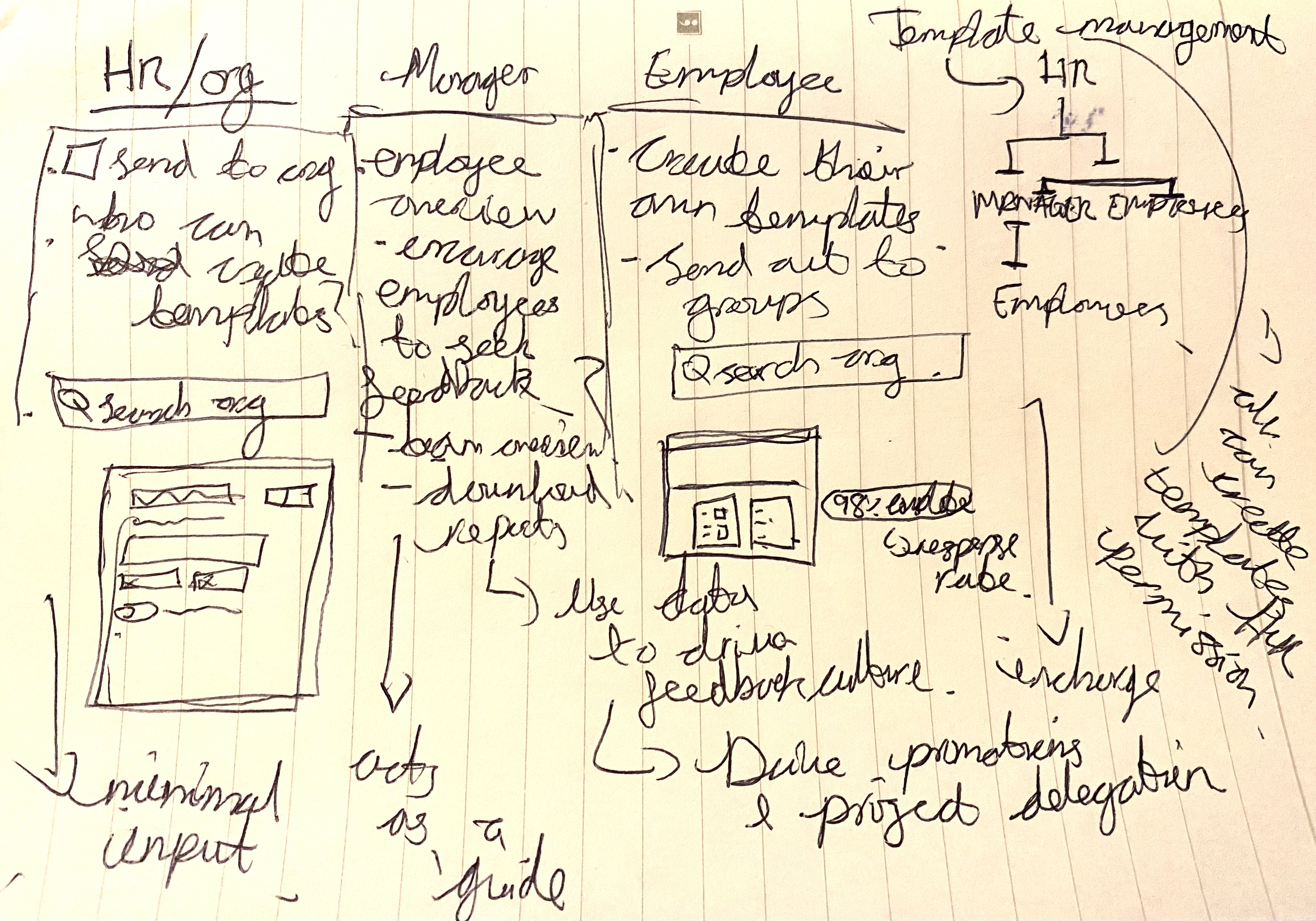
Figuring out the template hierarchy within a company and the permissions surrounding this.
template Permissions and Control Structure - Card Sorting
In order to understand how we should structure the permissions around the template functionality, I carried out a card sorting exercise to see how the users would expect us to organise these specific pieces of functionality.
5 users were tested with, they had varying roles belonging to at least 2 of these groups. Their roles were taken into consideration when finalising the results.
5 users were tested with, they had varying roles belonging to at least 2 of these groups. Their roles were taken into consideration when finalising the results.

A lot of 'on the fence' responses from a HR Manager here.

The beginning of the trend where I saw the ethos of 'putting the user in control of their feedback emerging'. This was a response from an employee.

The trend continues and was confirmed by 2 more card sorting sessions. This response is from a manager.
The results of the card sorting exercise showed that the user should be in control of their feedback but that the HR, CEO etc level people, still want to maintain some level of control over the organisation. We also had complaints about how visible the font was during this exercise, so we made sure to pick a more accessible font in future iterations.
Functionality permissions are as follows:
Org Level/HR - Controls company settings, who in the organisation can create templates. Whether that is specific people or the organisation as a whole. Controls basic organisational settings.
Manager - Can create and release templates to their team, can also see templates that their teams have active and what they have and haven't filled out. Managers act as guides to ensure their employee's gather good, useful feedback.
Employees - Can create, release and send templates to anyone they have worked with on behalf of themselves. There is an option for employees to make their template usable across the business or to them. Employees are really the ones in control on sending and receiving all feedback.
Functionality permissions are as follows:
Org Level/HR - Controls company settings, who in the organisation can create templates. Whether that is specific people or the organisation as a whole. Controls basic organisational settings.
Manager - Can create and release templates to their team, can also see templates that their teams have active and what they have and haven't filled out. Managers act as guides to ensure their employee's gather good, useful feedback.
Employees - Can create, release and send templates to anyone they have worked with on behalf of themselves. There is an option for employees to make their template usable across the business or to them. Employees are really the ones in control on sending and receiving all feedback.
user Testing and Feedback
Testing types
• Online user testing scenarios
• Customer Feedback group demos
• Card sorting exercise - considerations as above
Feedback Results
Quotes from HR members feedback:
• "Is it too much flexibility, do we need this much? Shouldn't we be able to standardise the process in HR. A company standard"
• "Can we control all the templates across the business?"
• "Can we include AI to help us write the surveys?"
Quotes from Employee feedback:
• "In the Employee Control - Could increase employee engagement? Employees don't always use the system properly."
• "I want good, constructive, candid and regular feedback! This helps me do this."
• "I really struggle with blank page syndrome, especially on pages like this.'
Quotes from Manager feedback
• "I like that you've put put the employee in control, that they can create templates, it gives them autonomy over their own development"
• "I struggle to find time to do this, every day is different."
Conclusion and Moving Forward
Feedback is overall positive, the main request was around including generative AI.
Weirdly however, users had comments that weren't related to the UX/UI, and more around culture based and internal business adoption. This needed further investigating.
• Online user testing scenarios
• Customer Feedback group demos
• Card sorting exercise - considerations as above
Feedback Results
Quotes from HR members feedback:
• "Is it too much flexibility, do we need this much? Shouldn't we be able to standardise the process in HR. A company standard"
• "Can we control all the templates across the business?"
• "Can we include AI to help us write the surveys?"
Quotes from Employee feedback:
• "In the Employee Control - Could increase employee engagement? Employees don't always use the system properly."
• "I want good, constructive, candid and regular feedback! This helps me do this."
• "I really struggle with blank page syndrome, especially on pages like this.'
Quotes from Manager feedback
• "I like that you've put put the employee in control, that they can create templates, it gives them autonomy over their own development"
• "I struggle to find time to do this, every day is different."
Conclusion and Moving Forward
Feedback is overall positive, the main request was around including generative AI.
Weirdly however, users had comments that weren't related to the UX/UI, and more around culture based and internal business adoption. This needed further investigating.
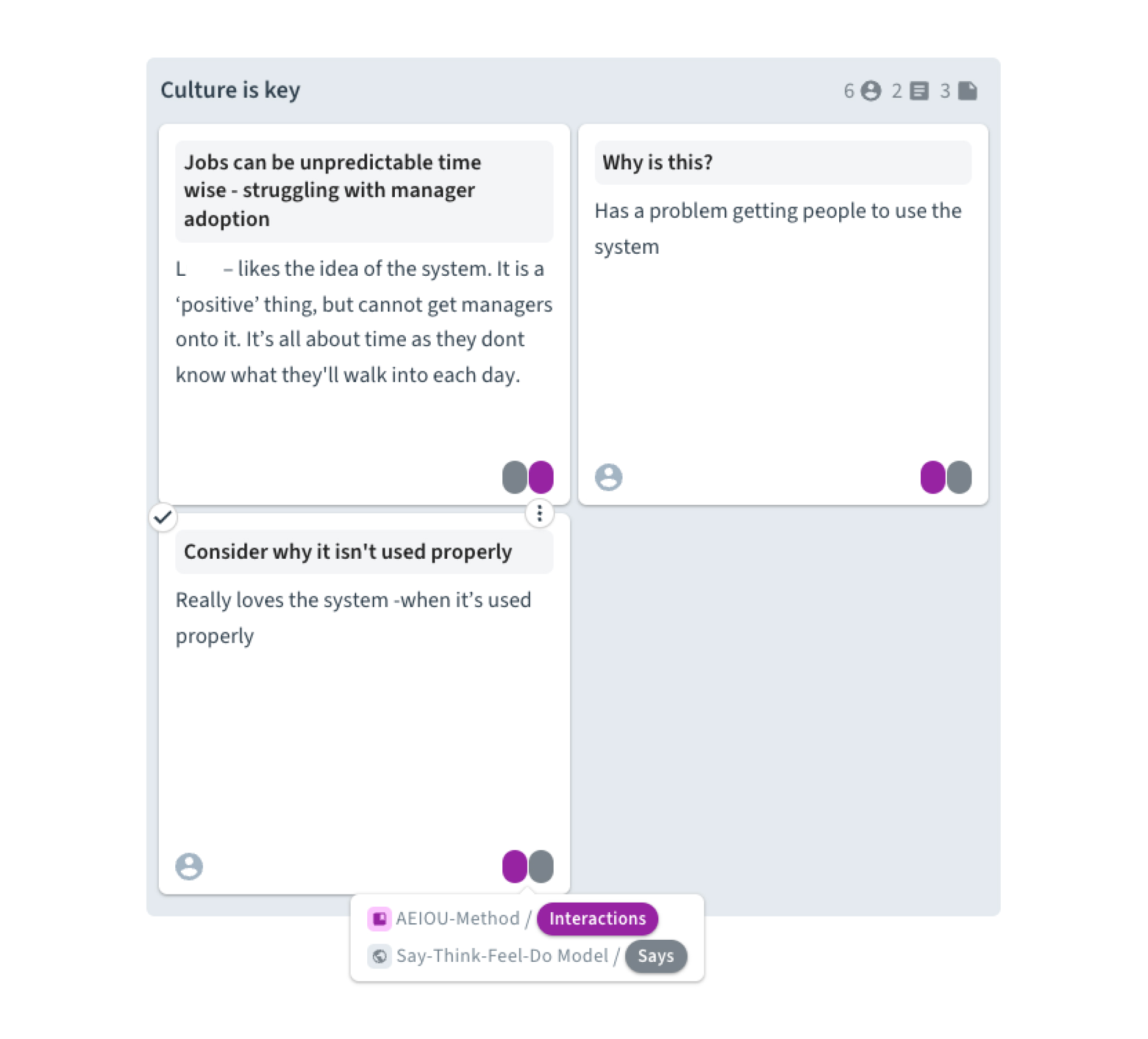
Analysing qualitative data comments from user testing around culture and adoption. I tag comments to help reveal themes in the 'Condens' platform.
Feedback changes - Creating a good Company Feedback Culture
As a company we can only do so much to encourage regular use of our performance management tool, we can make it easy to use, but not mandatory as a B2B product.
By speaking to different companies I found that employees regularly giving feedback is usually tied into the company ethos and initiatives on specific days (see graph below). However we do see that when asked often to give feedback, the feedback looses meaning.
We also see companies who give little feedback, but when they do, the quality is high.
UX is key in order to help harvest a good culture, not the solution to the culture. But we can use this data to help educate customers on how to help increase adoption.
By speaking to different companies I found that employees regularly giving feedback is usually tied into the company ethos and initiatives on specific days (see graph below). However we do see that when asked often to give feedback, the feedback looses meaning.
We also see companies who give little feedback, but when they do, the quality is high.
UX is key in order to help harvest a good culture, not the solution to the culture. But we can use this data to help educate customers on how to help increase adoption.

The data here shows that users submit most of their Feedback on Monday's, Wednesdays and Fridays showing a pattern of company incentives.
Feedback changes - Dev Capacity Issues - Scaling back Generative AI despite user feedback
It is clear as a result of user testing during both this project and previous projects, that users are struggling with 'blank page syndrome'. AI providing the 'bare bones' of a survey and feedback answers in general would help with this.
I instead suggested that we would implement generative AI initially within a part of the system (generic feedback page) in order to understand usage and adoption. When we did this, we saw that adoption was 0.8% (see below) over 180 days. Therefore myself and the designer I lead theorised that users may need more time to adapt to AI before we implement it product wide. Regardless, Further research and user testing is required.
I instead suggested that we would implement generative AI initially within a part of the system (generic feedback page) in order to understand usage and adoption. When we did this, we saw that adoption was 0.8% (see below) over 180 days. Therefore myself and the designer I lead theorised that users may need more time to adapt to AI before we implement it product wide. Regardless, Further research and user testing is required.

Measuring Success, How Might We's and next steps
How are we measuring success?
• There is minimal 'onboarding' or companies to get going with 360 feedback, (e.g. difficulty using the process, time taken for training and integrating a new process.) - Success - No training or extra support needed.
• There is minimal impact on support and the product team. - Not a success - Some education still needed initially on good feedback culture.
• Template functionality assists in driving continuous, candid and proven to be helpful feedback which can be used as a USP. - Partial Success - Users have commented that since our updates and changes to this functionality within a customer led UAT process that this will help support driving a comtinious feedback culture.
Did we solve our 'HMWs'?
• Put the employee in charge of their own feedback by allowing them to take charge of their templates. - Success - Employees are fully in charge of creating templates and sending them to whoever they wish. Providing this is allowed at a HR/Organisational level.
• Make it easy to create surveys with a consistent UX approach that aligns with both the product and the platform. - Success - This is now aligned with the platform and has been designed inline with the product as a whole and with a look to the future including the implementation of the new design system (Mosaic).
• Ensure considerations are made for each persona. - Success - In-depth considerations were made for each persona including developing persona specific workflows.
• Ensure business needs are met, feedback should help drive performance. -Success - Business needs discussed throughout feedback have been included and considered. Functionality assists feedback culture.
• Lock/restrict access to templates for certain users to some templates. - Success - Users can lock/restrict access to any templates that they make. HR can do this on an organisational level also.
• Allow users to create their own style of templates, not just multiple choice etc. - Success - Users have a choice of question style.
• Ensure users can edit their template at a later date. Add/remove questions, change the wording etc. - Success - This can be done.
• Allow for a 'comments' section at the end of every question in order for users to add any further details they wish. - Do not assume the questions will cover everything. - Success - This has been included.
• Ensure reminders to fill out the forms are sent at well timed intervals and consider if email is still appropriate. - Not successful - Out of scope, to be included in a future sprint.
Next Steps
• Take more steps towards making the product WCAG AA compliant - could we incorporate improvements when we add new functionality?
• Discuss adding a search into the templates page. It was out of scope for this sprint. To do in a future sprint.
• Include email reminders to fill out the surveys are sent at well timed intervals and consider if email is still appropriate within a future sprint. Consider the UI design for this, they are currently 'off brand'.
• Design PDF reports so that they can be understood quickly using infographics.
• There is minimal 'onboarding' or companies to get going with 360 feedback, (e.g. difficulty using the process, time taken for training and integrating a new process.) - Success - No training or extra support needed.
• There is minimal impact on support and the product team. - Not a success - Some education still needed initially on good feedback culture.
• Template functionality assists in driving continuous, candid and proven to be helpful feedback which can be used as a USP. - Partial Success - Users have commented that since our updates and changes to this functionality within a customer led UAT process that this will help support driving a comtinious feedback culture.
Did we solve our 'HMWs'?
• Put the employee in charge of their own feedback by allowing them to take charge of their templates. - Success - Employees are fully in charge of creating templates and sending them to whoever they wish. Providing this is allowed at a HR/Organisational level.
• Make it easy to create surveys with a consistent UX approach that aligns with both the product and the platform. - Success - This is now aligned with the platform and has been designed inline with the product as a whole and with a look to the future including the implementation of the new design system (Mosaic).
• Ensure considerations are made for each persona. - Success - In-depth considerations were made for each persona including developing persona specific workflows.
• Ensure business needs are met, feedback should help drive performance. -Success - Business needs discussed throughout feedback have been included and considered. Functionality assists feedback culture.
• Lock/restrict access to templates for certain users to some templates. - Success - Users can lock/restrict access to any templates that they make. HR can do this on an organisational level also.
• Allow users to create their own style of templates, not just multiple choice etc. - Success - Users have a choice of question style.
• Ensure users can edit their template at a later date. Add/remove questions, change the wording etc. - Success - This can be done.
• Allow for a 'comments' section at the end of every question in order for users to add any further details they wish. - Do not assume the questions will cover everything. - Success - This has been included.
• Ensure reminders to fill out the forms are sent at well timed intervals and consider if email is still appropriate. - Not successful - Out of scope, to be included in a future sprint.
Next Steps
• Take more steps towards making the product WCAG AA compliant - could we incorporate improvements when we add new functionality?
• Discuss adding a search into the templates page. It was out of scope for this sprint. To do in a future sprint.
• Include email reminders to fill out the surveys are sent at well timed intervals and consider if email is still appropriate within a future sprint. Consider the UI design for this, they are currently 'off brand'.
• Design PDF reports so that they can be understood quickly using infographics.

Feedback from Clear Review's Product Manager.
The Final Designs
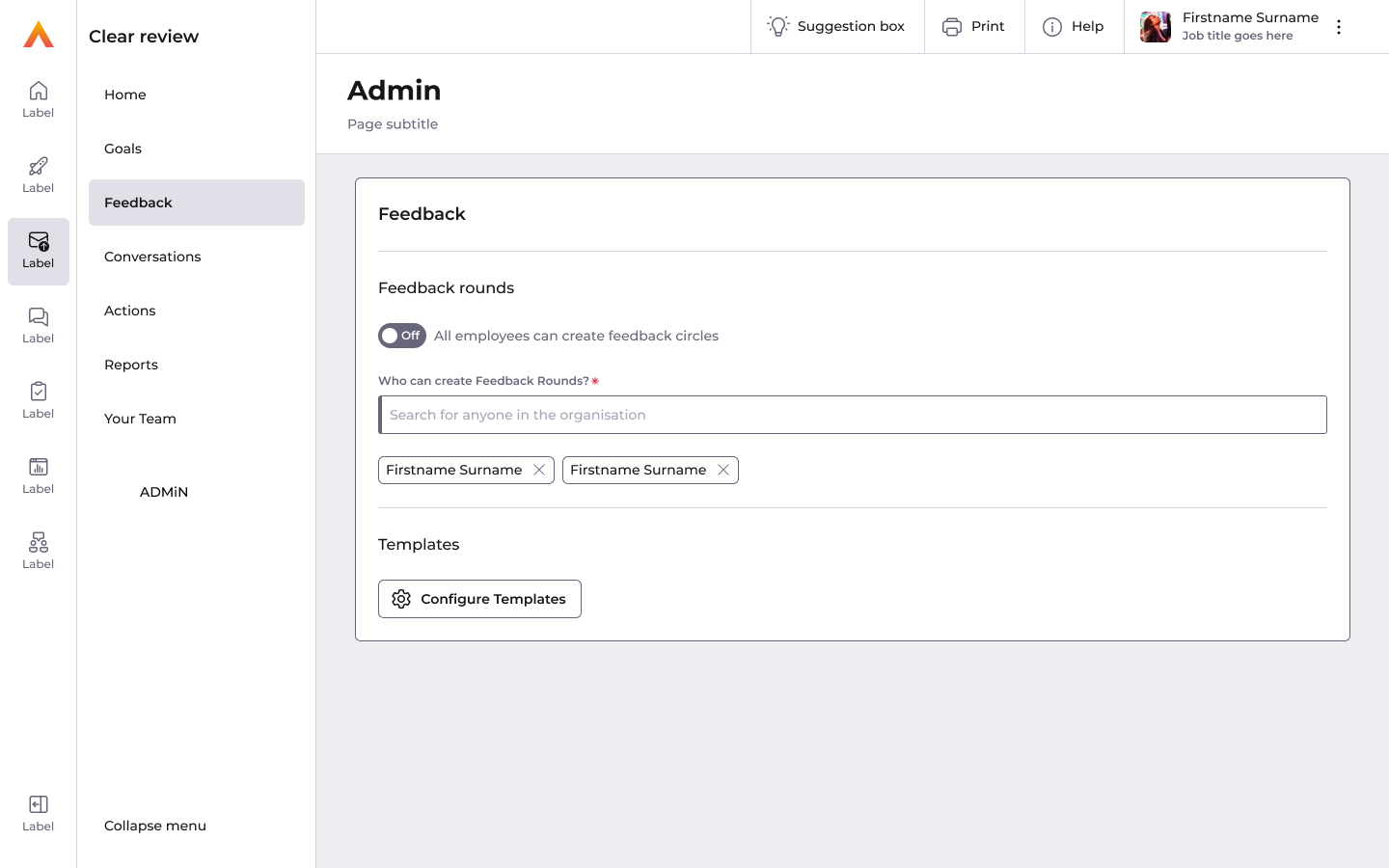
What is seen at an Org/HR level - Not a huge amount of settings in order to put control back into the hands of the employees. - Admin persona

A single choice question being added to a question within a template. - Admin persona
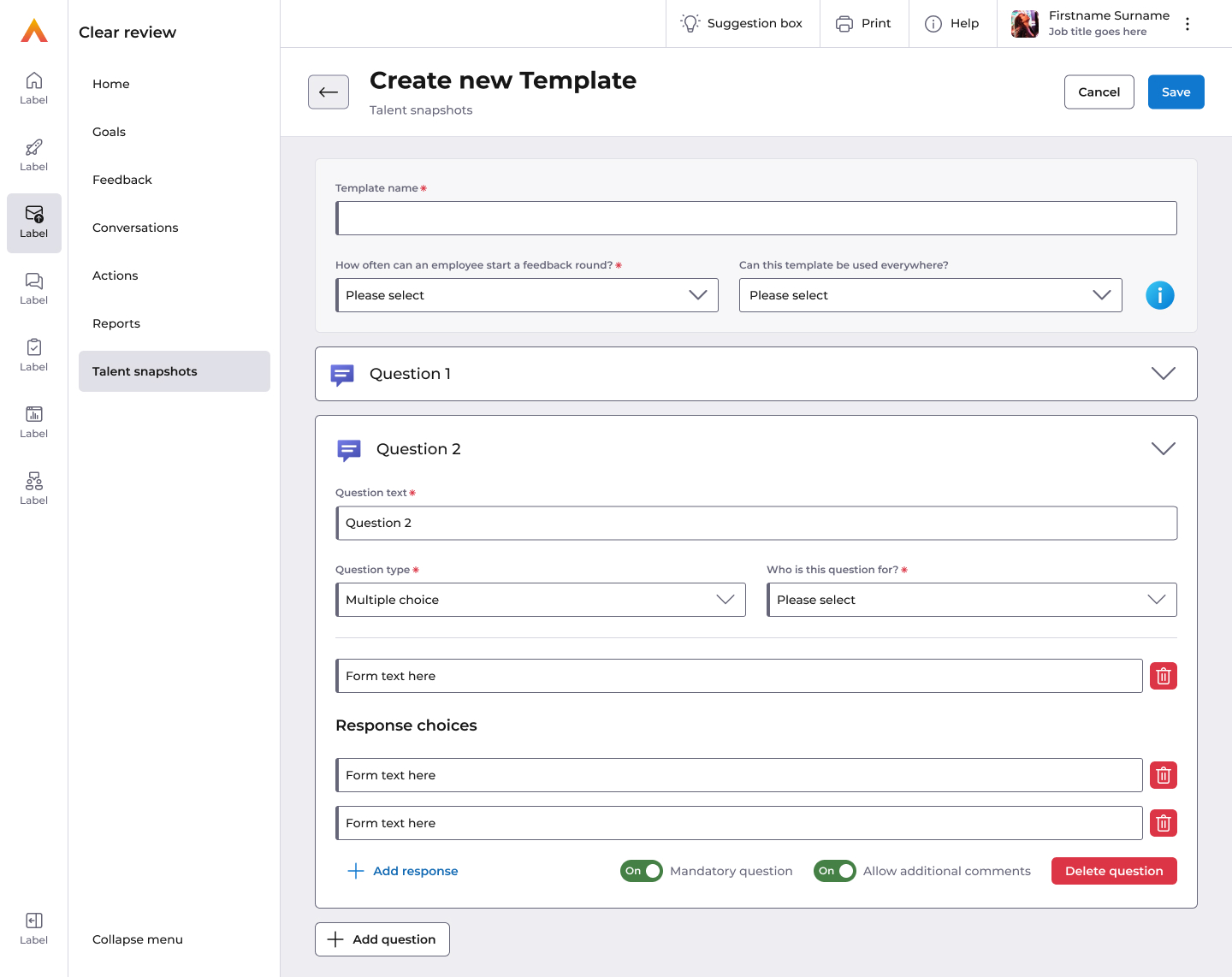
A multiple choice question being added to a question within a template. - Admin persona

Settings available to create surveys. I wish we could have included question ordering functionality here, but it was out of scope. - Admin persona
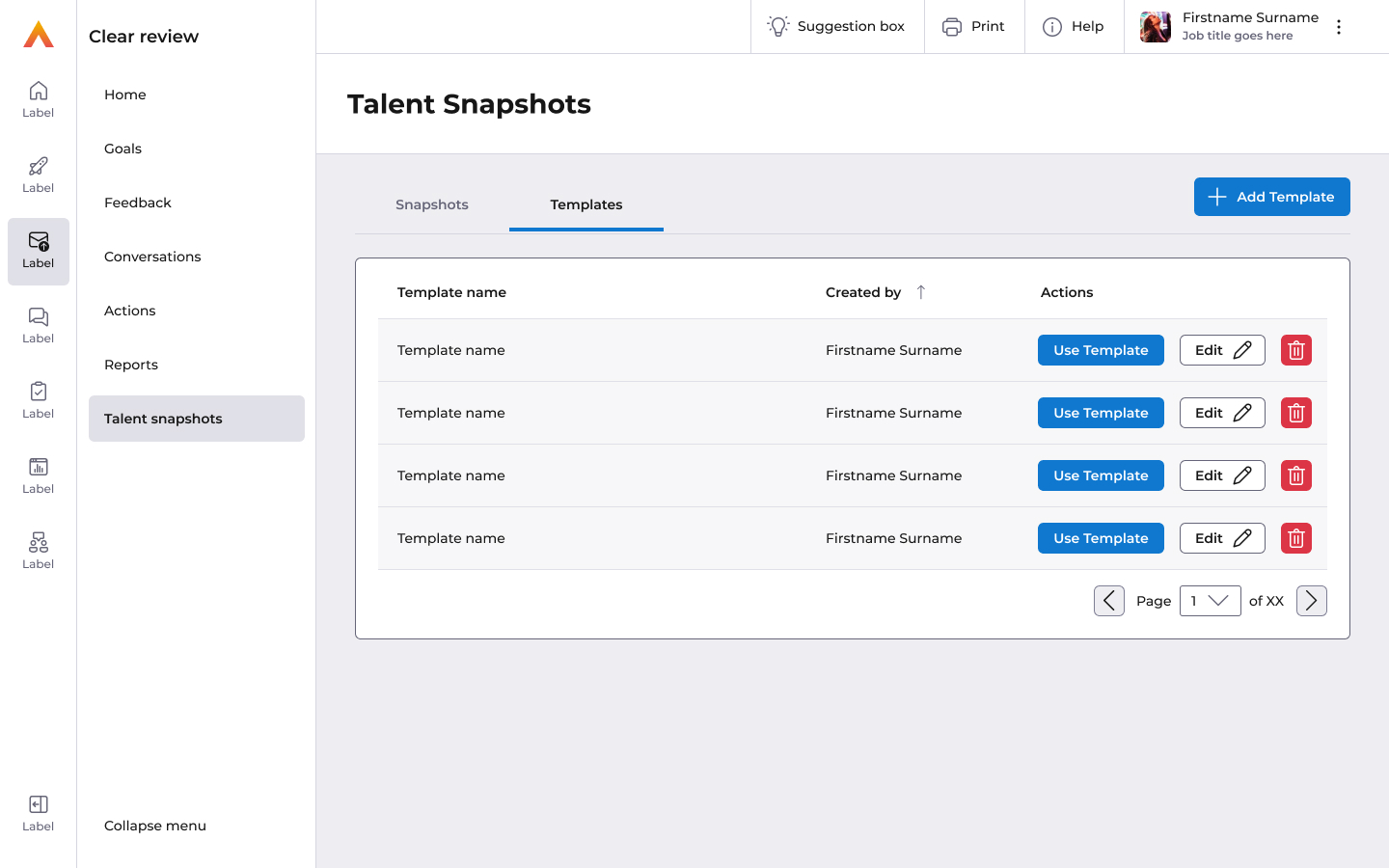
Template landing/overview page - manage all of your templates here. - Admin persona
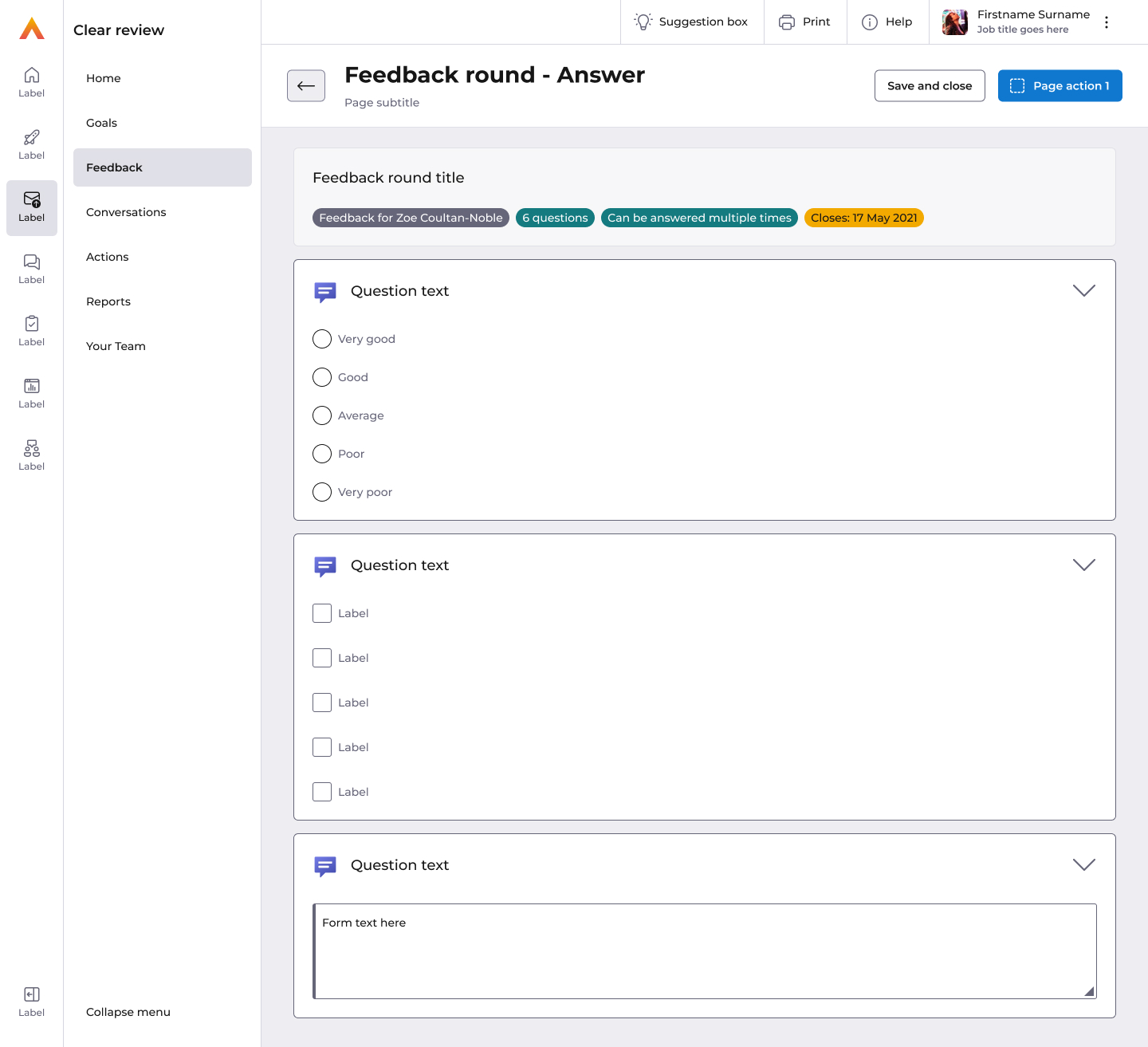
How a user would see the feedback survey from their colleague. - Employee persona
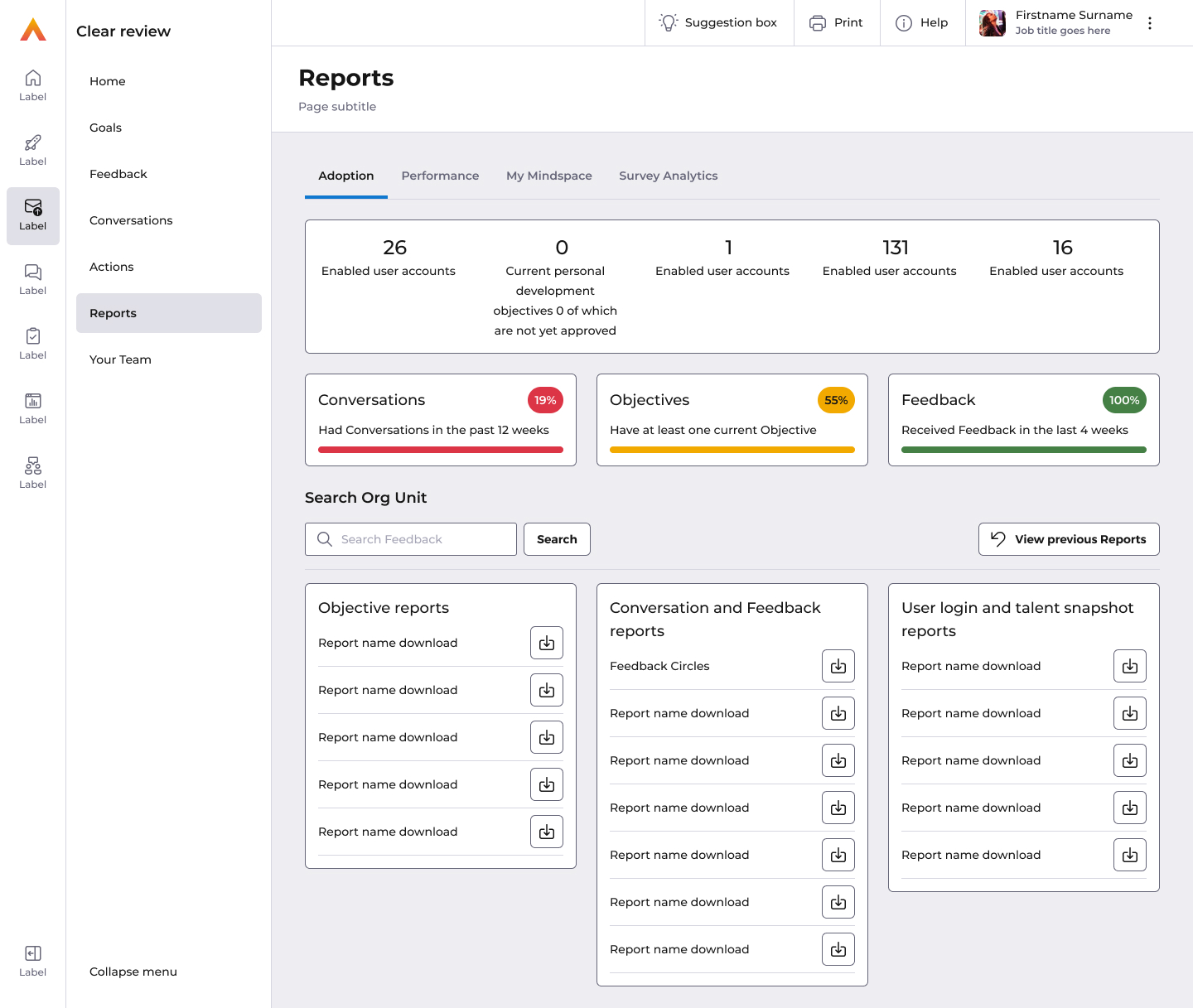
An option to download your feedback round as a PDF - The design for the PDF was out of scope for this sprint unfortunately.
